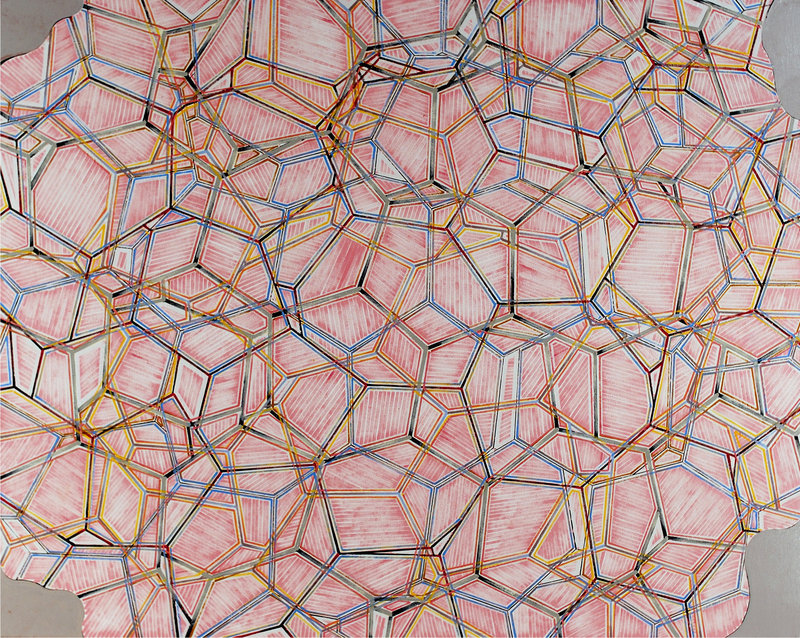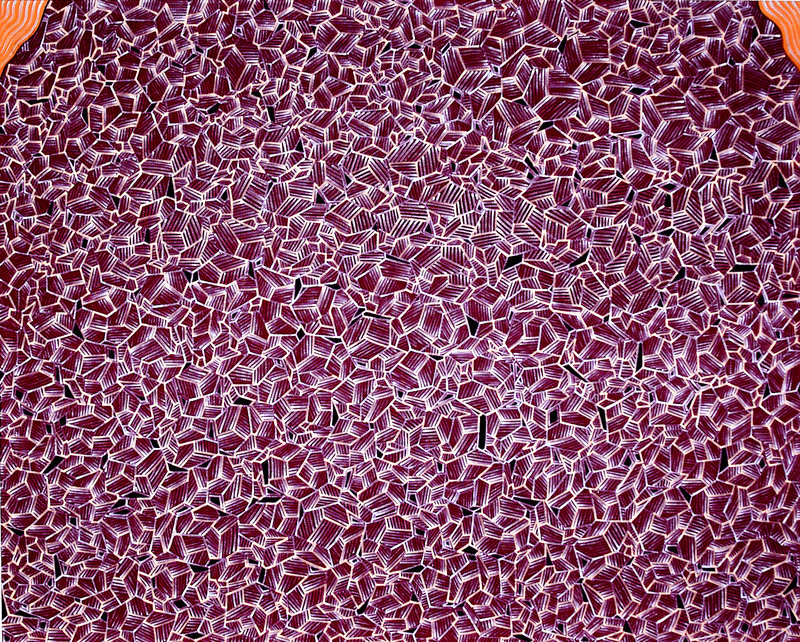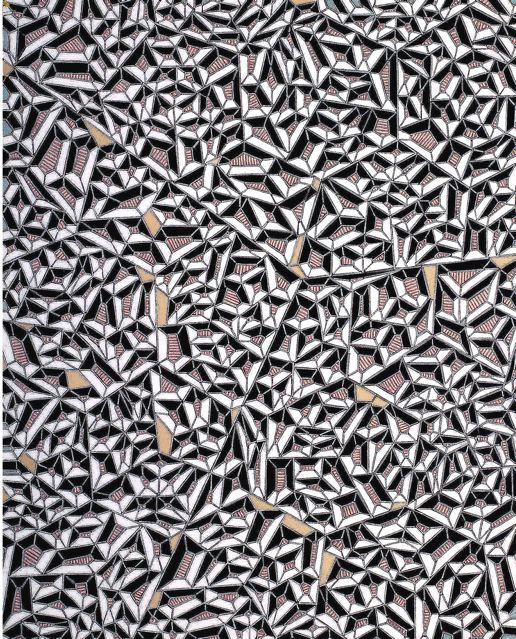Fred Lynch creates abstract art that is based in geometry and loaded with mathematical qualities.
With a surface glance, his work appears precise and measured. His lines are straight, his edges sharp, his details exacting.
But we all know that appearances are deceiving.
Widely respected as one of Maine’s foremost contemporary painters, Lynch finds inspiration for his work in the randomness of nature. It might be the way the branches of a tree intersect the horizon, or how winter rodents leave patterns in the grass after the spring thaw.
“The natural world often reaffirms what I am thinking about,” says the artist, who lives in Saco with his wife, Janice, who also is a painter.
Now in his mid-70s, Lynch is in the midst of a series of public engagements that have thrust his work in the public eye.
This spring, he is showing a range of recent paintings, sculptures and drawings at the Portland Museum of Art. In May, he will include drawings that he completed over the winter in a group show at Icon Fine Art in Brunswick, one of his longtime galleries.
He also refurbished his “Sentinels” installation for the Portland Public Library. As part of the library’s renovation, his work that was originally hung in 1986 has been hung again with more prominence — a happy prospect for him. “They were easy to miss in the old library,” he says. “Now they’re quite out in the open.”
To top it all off, he also serves as the sole juror for the first “Mill-ennial,” a biennial exhibition of contemporary art by artists from Saco, Biddeford and Old Orchard Beach. “Mill-ennial” opens Friday at the Saco Museum and at North Dam Mill in Biddeford.
During an interview at his studio in his home in Saco, Lynch allows that, yes, he has been busy. But he quickly adds that being busy is nothing new.
“It seems that I’ve always managed to stay active. Ideas come, and I act on them,” he says.
His work table attests to his activity. It is covered with projects in various states of completion, including small blocks of medium-density fiberboard that he engraves by hand with tools used by dentists and then rubs with ink. Off to the side are chunks of marble that he’s experimenting with, more relief sculptures and drawings.
This activity follows a familiar pattern that has marked Lynch’s career for most of the past three decades or more. He has made a habit of taking an idea, pursuing it vigorously to the point of exhaustion and then moving on to a new idea, which often evolves from a prior pursuit.
His recent history attests to those work habits. In the early 2000s, he began making paintings that he calls his Division series. They are large-scale and finely detailed oil-on-canvas paintings of interconnected geometric shapes, shaded in various colors. The shapes all stem from his interest in a 120-degree angle.
Think of the peace sign. That spot where the three lines meet near the middle of the circle forms the angle that Lynch is most interested in exploring. But his exploration is rough. He doesn’t measure his angles, and prefers that they all be a little off. Not only do the rough angles fit his philosophy of not being too precise, they also serve his desire to capture happy accidents.
“drawing close to 120-degree angles, invariably you get variations, which result in unexpected shapes and directions,” he says. “I am mostly interested in discovering new shapes that are gotten by my quasi-system of 120-degree divisions.”
He pauses, then adds with a laugh, “I can paint it better than I can explain it.”
Lynch made those paintings for several years and more recently has begun creating painted relief sculptures, made with wood, from the shapes that emerge within his angles.
The exhibition at the Portland Museum of Art, on view through July 11, focuses on the paintings, drawings and sculptural forms that resulted from Lynch’s Division series. The PMA show is titled “Division and Discovery.”
Three of the large paintings hang in the Great Hall. The balance of the work is upstairs.
Lynch is proud of the work at the PMA. He likes the way the show looks, and is happy that so many people have the chance to see it.
“I’m delighted to see my work in well-lit surroundings. You can really see them there,” he says. “The big paintings I can’t show too much, because they are very large. And there are some in the exhibition that I have never shown before.”
Lynch has a long history in Maine. He moved here in 1972, after spending several years teaching at Westfield State College in western Massachusetts.
He was happy at Westfield, but felt that his life was becoming too settled, too routine. “I needed something else,” he says.
That pattern of stepping out of his comfort zone has marked his professional life.
When he came to Maine, he went all the way to Lubec to learn boat building, which he loved. He came to the Portland area in the late ’70s, and has been here since. He taught at the University of Southern Maine for 25 years, stepping away from teaching in 2006.
In Maine, his work is in the collections of the PMA, the Farnsworth Art Museum and at USM.
Duane Paluska, who owns the Icon gallery in Brunswick, considers Lynch one of Maine’s most accomplished contemporary painters.
“I respect the fact that he is constantly searching. He has, like all of us who make art, a limited — if I can use that without being pejorative — a limited number of things that he is interested in and what he can do,” Paluska said. “But he is constantly re-evaluating those things and coming up with ways to add or subtract elements, or think about them or combine them in a different medium. He’s always coming up with work that is clearly and uniquely Fred.
“He is remarkably productive without being repetitive. The combination of being productive without being repetitive is absolutely amazing.”
Paluska is particularly excited about showing a few of Lynch’s latest drawings, completed over the winter, in a group show that opens in May. “They are some of his absolute best things,” Paluska said. “They’re just faultless. You frequently look at someone’s work, and you think, ‘Terrific, but I wish he had done this instead of that.’ But you look at those drawings, and you can’t improve on them.”
Mary Harding, who operates the George Marshall Store Gallery in York, is also a fan, and has been for many years.
“He is such a sincere and committed artist. If you look at this work over the decades, there is this wonderful thread of continuity of an idea. Even in his earlier figurative work, it’s in there. He has found a way to continue that thread through every phase of his work over the decades, which is remarkable,” she said.
Lynch’s biggest fans, perhaps, are Kelly and Jane Littlefield of Old Orchard Beach. They began collecting his paintings 15 or 20 years ago, and own several paintings from many periods of his career.
Over the years, the Littlefields have gotten to know Lynch personally, often visiting with him in his studio for hours at a time. Last year, the Littlefields opened a seasonal gallery at their summer home in Winter Harbor.
Lynch offered several pieces as a way to give their gallery a boost.
“He went out of his way to be helpful to us,” Kelly Littlefield said. “He’s well-established. He’s got shows in the biggest museums in Maine, and he takes the time and goes above and beyond to do more than he has to. That level of kindness is unusual, and we really appreciate it.”
Staff Writer Bob Keyes can be contacted at 791-6457 or at:
bkeyes@pressherald.com
Send questions/comments to the editors.






Success. Please wait for the page to reload. If the page does not reload within 5 seconds, please refresh the page.
Enter your email and password to access comments.
Hi, to comment on stories you must . This profile is in addition to your subscription and website login.
Already have a commenting profile? .
Invalid username/password.
Please check your email to confirm and complete your registration.
Only subscribers are eligible to post comments. Please subscribe or login first for digital access. Here’s why.
Use the form below to reset your password. When you've submitted your account email, we will send an email with a reset code.